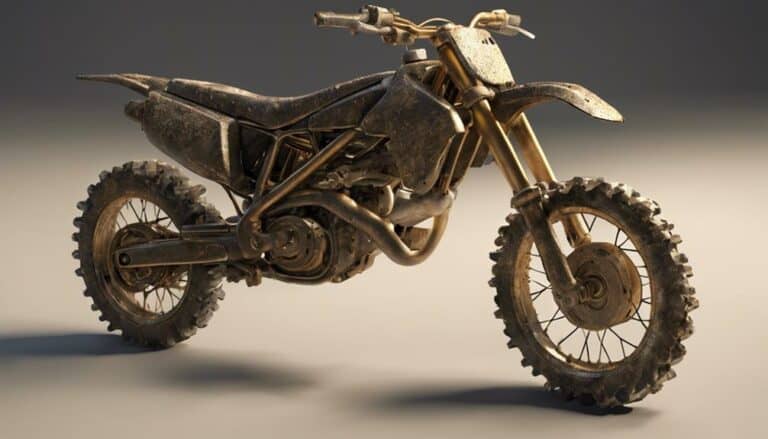If you notice a darkening of your dirt bike engine oil color or experience unusual engine noises, it might be time for a change. However, these are just the beginning.
Understanding the signs that indicate your engine oil needs attention is essential for top performance and engine health.
So, what other subtle yet critical indicators should you be aware of to guarantee your dirt bike engine runs smoothly?
Key Takeaways
- Darkening oil color indicates dirt accumulation, signaling the need for an oil change.
- Engine noise like knocking suggests insufficient lubrication, prompting oil change consideration.
- Low oil levels lead to overheating and engine damage, emphasizing timely oil level checks.
- Monitoring oil levels and color prevents performance decline and potential engine seizure.
Oil Color Changes
If you notice your dirt bike engine oil turning from a light brown hue to a dark black color, it's likely time for an oil change to maintain proper lubrication.
Fresh engine oil starts off light brown but darkens as it accumulates dirt and contaminants from the engine parts. The darkening of the oil color is a clear sign that your motorcycle needs regular oil changes to guarantee the engine's best performance.
Monitoring the oil color changes is important as black and gritty oil indicates the presence of impurities like dirt, dust, and carbon deposits. These impurities can compromise the lubrication capacity of the oil, potentially leading to engine damage.
Low Oil Levels
When your dirt bike's engine oil levels are low, it puts your engine at risk of damage and increased friction. Insufficient oil can lead to overheating and reduced lubrication of engine parts, potentially causing engine seizure. To guarantee your dirt bike's engine remains in top condition, it's essential to monitor the oil levels regularly. Neglecting to maintain adequate oil levels can result in costly repairs and impact the performance and reliability of your motorcycle.
Here are some key points to ponder regarding low oil levels:
- Low oil levels can lead to engine overheating.
- Inadequate lubrication due to low oil levels increases friction within the engine.
- Regularly checking and maintaining proper oil levels is pivotal for peak engine function.
- Lack of oil can cause severe engine damage and potential engine seizure.
- Keeping your dirt bike's oil levels sufficient is essential for the longevity of your engine and overall performance.
Engine Noise Increases
Experiencing an increase in engine noise on your dirt bike signals a potential need for an oil change. Unusual loudness or metal-on-metal sounds coming from the engine can indicate insufficient lubrication, which is essential for protecting engine components.
When you notice loud knocking or rattling sounds that are out of the ordinary, it's a clear sign that your engine oil may be old and no longer providing adequate lubrication. Monitoring changes in engine noise compared to its usual operation is key in detecting when an oil change is necessary to prevent potential engine damage.
Addressing engine noise promptly is vital to maintaining the health of your dirt bike engine. Ignoring these sounds can lead to increased wear and tear on vital parts, potentially resulting in costly repairs. By staying vigilant and recognizing the signs that your engine oil needs changing, you can assure your dirt bike engine continues to perform optimally.
Performance Declines
Noticing a decline in your dirt bike's performance, such as reduced acceleration or power loss, may indicate the need for an oil change. When your engine oil is no longer providing adequate lubrication, various performance issues can arise. Check for the following signs to determine if your dirt bike's engine oil needs changing:
- Warning lights on your dashboard illuminate, signaling potential engine problems.
- Unusual engine sounds like knocking or ticking indicate insufficient lubrication.
- Increased exhaust smoke or a burning smell while riding could be a result of old oil.
- Parts in the engine may start rubbing together due to lack of proper lubrication.
- If your oil appears light brown or discolored, it's time to replace it to ensure all engine parts are lubricated effectively.
Regularly monitoring the oil level and color is essential to maintaining top-notch engine performance and avoiding potential damage.
Overheating Risk
To mitigate overheating risks in your dirt bike engine, ensuring adequate oil lubrication is essential for maintaining peak performance and preventing potential damage. Proper lubrication reduces friction and heat buildup within the engine, safeguarding against issues like piston scuffing and cylinder wall damage that can arise from overheating. Without sufficient oil levels, the engine components are at risk of reaching high temperatures, which can lead to catastrophic engine failure. Monitoring your oil levels regularly and changing the oil when needed is critical to prevent these overheating risks and protect your dirt bike's engine.
| Engine Overheating Risks | Effects on Engine Components | Importance of Proper Lubrication |
|---|---|---|
| Potential piston scuffing | Damage to cylinder walls | Reduces friction and heat |
| Increased heat levels | Risk of catastrophic failure | Ensures peak performance |
| Higher chance of failure | Reduced engine lifespan | Prevents engine damage |
Conclusion
So, next time you're out riding your dirt bike, remember to keep an eye on your engine oil. Just like a well-oiled machine, your bike needs the right lubrication to keep running smoothly.
Ignoring the signs of needing an oil change is like driving a car with low fuel – eventually, you'll come to a screeching halt.
Stay proactive and maintain your oil levels for peak performance on the trails.

